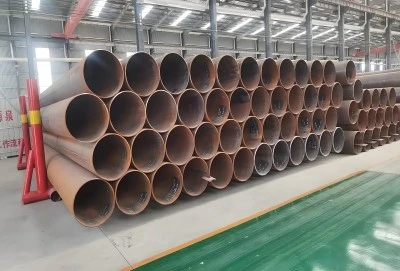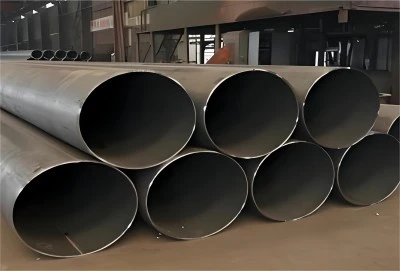The API 5L X60 PSL2 steel pipe is a crucial component in the oil and gas industry, known for its exceptional strength, durability, and resistance to corrosion. This high-performance pipe is manufactured to meet the stringent requirements of the American Petroleum Institute (API) 5L specification, ensuring its reliability in demanding applications. In this comprehensive guide, we'll delve into the intricate manufacturing process of API 5L X60 PSL2 steel pipes, exploring each stage from raw material preparation to the final quality control measures.
|
|
|
Raw Material Preparation
The journey of an API 5L X60 PSL2 steel pipe begins with the careful selection and preparation of raw materials. The primary component is high-quality steel, typically a low-carbon or micro-alloyed steel that meets the chemical composition requirements specified by API 5L standards. This steel is chosen for its optimal balance of strength, toughness, and weldability – essential characteristics for pipes used in oil and gas transportation.
The steel-making process involves several steps, starting with the careful selection of iron ore, coal, and limestone. These raw materials are processed in a blast furnace to produce pig iron, which is then refined in a basic oxygen furnace or an electric arc furnace to create molten steel. During this stage, alloying elements such as manganese, nickel, chromium, and molybdenum may be added to enhance the steel's properties and meet the specific requirements of API 5L X60 PSL2 grade.
Once the molten steel reaches the desired composition, it undergoes continuous casting to form slabs. These slabs are then hot-rolled into steel coils or plates, depending on the pipe manufacturing method to be used. The hot-rolling process not only shapes the steel but also improves its microstructure and mechanical properties.
Quality control begins at this early stage, with rigorous testing of the steel's chemical composition and mechanical properties. This ensures that the raw material meets the stringent requirements of API 5L X60 PSL2 specification before proceeding to the next stage of pipe manufacturing.
Forming And Welding
Once the raw materials have been prepared to meet the exacting standards required for API 5L X60 PSL2 steel pipes, the next crucial phase in the manufacturing process is forming and welding. This stage transforms the flat steel plates or coils into cylindrical pipes capable of withstanding the high pressures and corrosive environments typical in oil and gas applications.
The forming process for API 5L X60 PSL2 steel pipes typically employs one of two methods: the UOE process or the JCOE process. Both methods are designed to create large-diameter, high-strength welded pipes suitable for demanding applications.
In the UOE process, named after its three main steps (U-ing, O-ing, and Expansion), the steel plate is first bent into a U-shape using a powerful press. The U-shaped plate is then further formed into an O-shape, creating a cylindrical pipe with an open seam. The edges of this seam are carefully prepared for welding, ensuring a precise fit and optimal weld quality.
The JCOE process (Jacking, Crimping, Offsetting, and Expansion) is an alternative method that offers some advantages in terms of productivity and dimensional accuracy. This process involves crimping the edges of the plate, then progressively forming it into a pipe shape through a series of pressing operations.
Regardless of the forming method used, the next critical step is welding. For API 5L X60 PSL2 steel pipes, submerged arc welding (SAW) is commonly employed due to its ability to produce high-quality, consistent welds in thick materials. The SAW process involves creating an arc between a continuously fed electrode wire and the pipe seam, with the entire welding zone covered by a layer of granular flux. This flux protects the weld from atmospheric contamination and helps shape the weld bead.
The welding process typically involves multiple passes to ensure full penetration and optimal strength. The first pass, known as the root pass, is crucial for establishing the foundation of the weld. Subsequent fill and cap passes complete the weld, building up the required thickness and ensuring a smooth surface finish.
Throughout the welding process, strict controls are maintained over parameters such as heat input, travel speed, and electrode positioning. These factors significantly influence the weld quality and the pipe's overall integrity. Advanced welding equipment, often computer-controlled, helps maintain consistency and precision throughout the welding operation.
Quality Control And Post-processing
The final stage in the manufacturing of API 5L X60 PSL2 steel pipes involves comprehensive quality control measures and post-processing treatments. This phase is crucial in ensuring that every pipe meets the stringent requirements of the API 5L specification and is fit for its intended use in challenging oil and gas applications.
Quality control begins with non-destructive testing (NDT) of the welded seam. This typically involves ultrasonic testing (UT) and radiographic testing (RT) to detect any internal defects or inconsistencies in the weld. The entire pipe body is also subjected to ultrasonic inspection to ensure the absence of laminations or other material defects.
Hydrostatic testing is another critical quality control measure. Each pipe is pressurized with water to a level significantly above its intended operating pressure. This test verifies the pipe's structural integrity and its ability to withstand high internal pressures without leakage or failure.
Mechanical testing is conducted on samples taken from the pipe production. These tests include tensile strength tests, impact tests (such as the Charpy V-notch test), and hardness tests. The results must meet or exceed the requirements specified for API 5L X60 PSL2 grade pipes.
Dimensional checks are performed to ensure that the pipes meet the required specifications for diameter, wall thickness, length, and straightness. Advanced measuring equipment, including laser-based systems, may be used to achieve high accuracy in these measurements.
Surface inspection is another crucial aspect of quality control. Both the internal and external surfaces of the pipes are carefully examined for any defects, such as dents, gouges, or surface irregularities that could compromise the pipe's performance or corrosion resistance.
Post-processing treatments are often applied to enhance the pipe's properties and prepare it for its intended application. These may include:
- Heat treatment: Processes such as normalizing or quenching and tempering may be used to optimize the pipe's microstructure and mechanical properties.
- Coating application: Depending on the intended use, pipes may be coated with materials such as fusion-bonded epoxy (FBE) or three-layer polyethylene (3LPE) to provide additional corrosion protection.
- End finishing: The pipe ends are carefully prepared to facilitate field welding and ensure proper alignment during pipeline construction.
Throughout the quality control and post-processing stage, meticulous record-keeping is maintained. Each pipe is assigned a unique identification number, allowing for full traceability of its manufacturing history and test results.
China API 5L X60 PSL2 Steel Pipe
The manufacturing process of API 5L X60 PSL2 steel pipes is a complex and highly controlled operation, involving advanced technologies and skilled expertise at every stage. From the careful preparation of raw materials to the rigorous forming and welding processes, and finally through comprehensive quality control and post-processing treatments, each step is crucial in producing pipes that meet the exacting standards required for oil and gas applications.
The resulting API 5L X60 PSL2 steel pipes are a testament to the marriage of material science, engineering precision, and quality assurance. These pipes offer the strength, durability, and reliability necessary to withstand the harsh conditions and high pressures encountered in modern energy transportation systems.
As the global demand for energy continues to grow, the importance of high-quality, reliable pipeline infrastructure cannot be overstated. API 5L X60 PSL2 steel pipes play a vital role in this infrastructure, ensuring the safe and efficient transportation of oil and gas resources across vast distances.
Grades: B, X42, X46, X52, X56, X60, X65, X70, X80
Level: PSL2. If you are choosing your China API 5L X60 PSL2 steel pipe manufacturers, welcome to contact LONGMA GROUP at info@longma-group.com.














